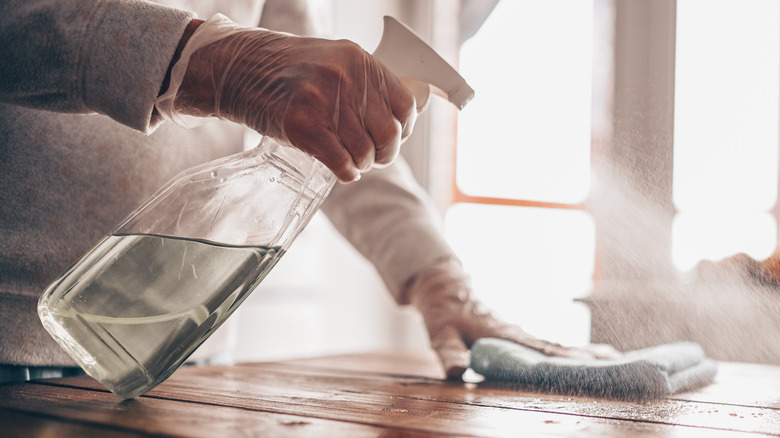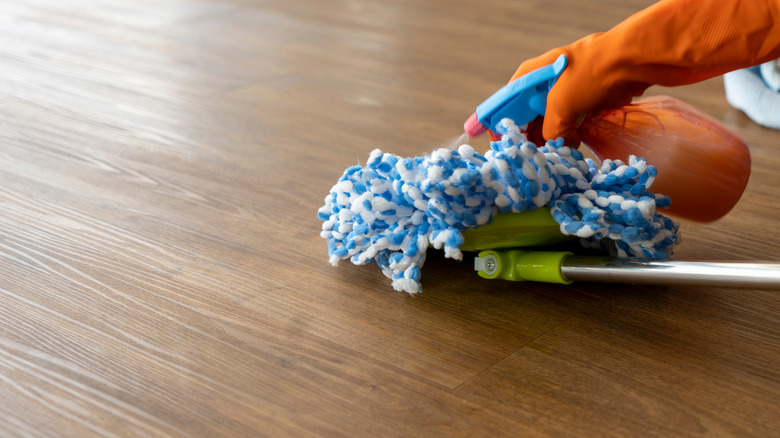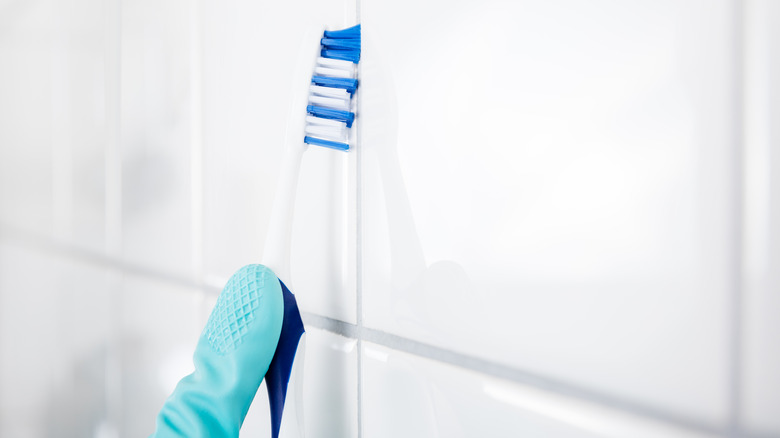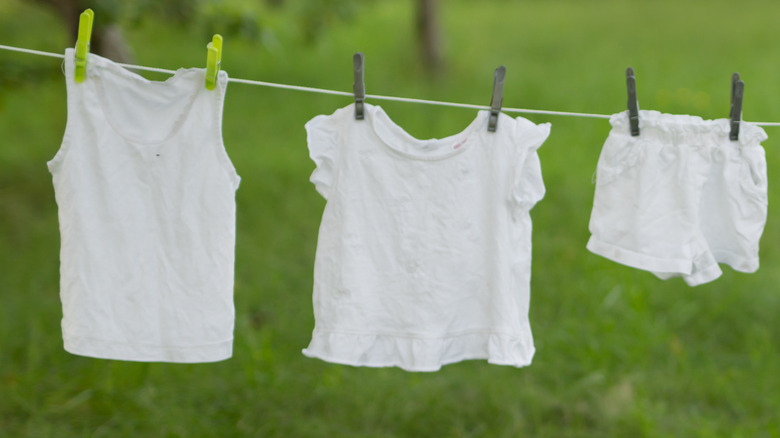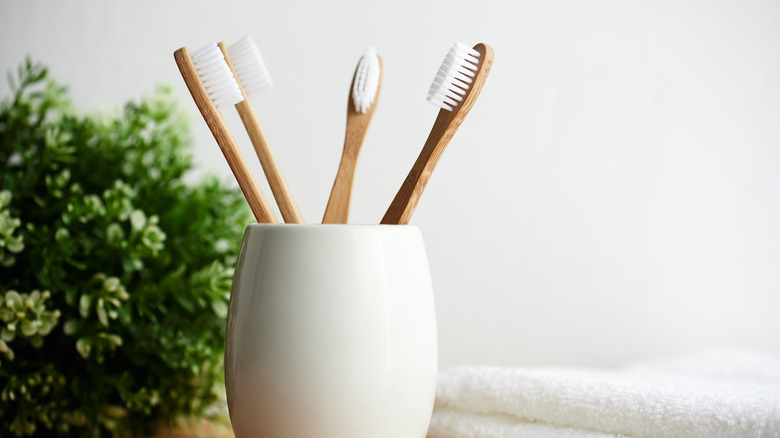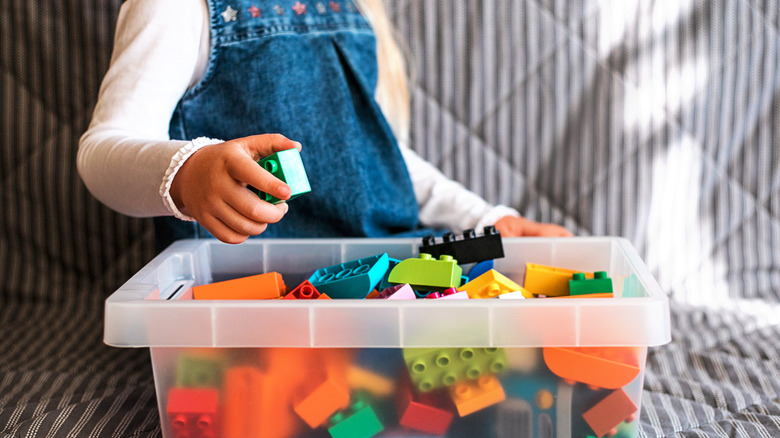Surprising Ways To Use Hydrogen Peroxide In Your Home
You can find hydrogen peroxide in most medicine cabinets, but have you ever considered how else it might be utilized around the house? While it's most commonly been dabbed on as an antiseptic for mild cuts or mouth sores, Healthline notes that medical professionals do not recommend using hydrogen peroxide on wounds any longer because it can slow down the healing process. But rather than trashing your little brown bottle of peroxide, consider its other uses. You'd be surprised where else it can come in handy.
Hydrogen peroxide has a similar chemical makeup to water (H2O), with one extra oxygen molecule (H2O2). In this chemical, two hydrogens are combined with two oxygen molecules. This slight difference makes it an effective oxidizer, which helps break down materials when cleaning. At the same time, its powerful oxidizing properties also give it a shorter shelf life as it's sensitive to light and other factors. So be sure to replace your opened bottle every six months (via Real Simple). Wear cleaning gloves when working with hydrogen peroxide to avoid irritating your skin, and you should never mix hydrogen peroxide with vinegar as a cleaning solution. Though they're terrific when used separately, the combo creates harmful fumes and form into corrosive acid (via Good Housekeeping). Instead, try out these other ways to use hydrogen peroxide safely around the house.
Clean floors with hydrogen peroxide
An unexpected way to use hydrogen peroxide in the home? Cleaning, sanitizing, and brightening floors. According to HouseLogic, given its mild makeup, hydrogen peroxide won't harm most floor types, but you should always spot test first. MacDonald Hardwoods notes that its bleaching properties are fine on wood flooring, but to use caution on the darkest stains. Fill a spray bottle with undiluted 3% hydrogen peroxide and wet the floor with it. Let it sit for a few minutes before wiping away with a soft cloth.
Hydrogen peroxide is especially effective in removing stains and odors from hardwood. Wood is porous, making it difficult to get the liquid stains it absorbs out completely. That's where hydrogen peroxide comes in. It can draw out the stain while drying out the wood simultaneously. For pet stains, Wood Floors Cleaner recommends soaking a soft cloth in 3% hydrogen peroxide, leaving it on top of the stain overnight, and then wiping clean the next day.
Whiten and clean grout with hydrogen peroxide
Have you noticed the grout looking grimy in the bathroom? This means it needs a good scrubbing, and with its mild bleaching properties, hydrogen peroxide can help. Real Simple recommends brushing the grout lines with hydrogen peroxide and a cleaning toothbrush, but there are other ways to tackle grout if you need a little more juice. Per Today, first spray tiles with hydrogen peroxide, wipe them down, and rinse. Then, get to work on the problem areas with a homemade paste of 2 teaspoons of cream of tartar mixed with some lemon juice.
Bob Vila has another solution if you don't have cream of tartar on hand. Combine 1/2 cup baking soda with 1/4 cup hydrogen peroxide in a squeeze-top bottle. Mix in 1 teaspoon of liquid dish soap, then shake the bottle. Soak the grout lines with the cleaner, let it sit for a few minutes, then wipe clean and rinse. The hydrogen peroxide will brighten the grout while baking soda lifts stains and removes hard water buildup.
Remove laundry stains with hydrogen peroxide
The laundry room is another place hydrogen peroxide comes in handy. According to The Spruce, it's safe to use on fabrics you can wash in regular cycles, though you should spot-test colors. First, hydrogen peroxide can be used in place of bleach. Try adding 1 cup of peroxide to the drum before adding clothes and filling with water (or add it to the bleach dispenser). Healthline writes that you can make a strong oxygen bleach by combining 1/2 cup of hydrogen peroxide with 1/2 cup of washing soda. Add it after the tub fills with water and let it sit for an hour before running the entire cycle.
Hydrogen peroxide effectively removes yellow underarm stains when combined with baking soda. It's also great on plant-based and protein-based spills. You can use it on stains from grass, fruit, juice, and wine by dabbing the stained area with hydrogen peroxide and letting it sit for 10 minutes before washing in a regular cycle. Finally, peroxide can also remove odors and mildew from fabrics and sneakers. Soak them in 1/2 cup of peroxide and enough water to fully submerge them for 30 minutes, then wash per usual.
Disinfect toothbrushes and other personal care items with hydrogen peroxide
We clean our teeth regularly to remove germs and food buildup, but what about the toothbrushes we use to get the job done? The American Dental Association has guidelines on storing and caring for toothbrushes, and disinfecting them regularly is not on the list. But if you drop your toothbrush and need to clean it, they say using hydrogen peroxide will do the trick. In fact, per Insider, studies have shown that soaking them in peroxide will kill pretty much all of the germs lingering there. Just fill a small cup with as much hydrogen peroxide as needed to cover the bristles, then let it sit for no longer than 15 minutes (to avoid damaging the bristles).
While you're at it, you can clean some of the personal care items in your medicine cabinet with hydrogen peroxide. Makeup brushes and blending sponges need to be cleaned regularly, and Bustle says soaking them in peroxide for five minutes will work wonders. To clean a loofah or sponge, Homesteady recommends filling a large bowl with 2 parts warm water, 1 part peroxide, then soaking the loofah for at least 30 minutes. And for shaving instruments, a 10-second dunk into hydrogen peroxide after using will disinfect razors.
Clean children's toys with hydrogen peroxide
Kids aren't exactly known for keeping their germs to themselves. And though the thought of cleaning 800 Legos might seem daunting, you can easily disinfect toys with hydrogen peroxide. Good Clean Health Co writes that hydrogen peroxide is ideal for cleaning up kids' toys because it doesn't contain bleach, acids, chlorine, or other chemicals that aren't safe for little hands. Mix equal parts of water with 3% hydrogen peroxide in a bucket or bowl to get started. Submerge the toys in the water. When little bubbles stop rising to the surface, you can dump out the toys and rinse them with clean water. This method is great for cleaning large quantities of small plastic toys.
If toys have batteries, remove them first. Then, using the same ratio of peroxide and water, dip a cloth into the mixture and wipe the toys clean. You can also use this method for wood toys and other materials you shouldn't submerge in water. HouseLogic also recommends filling a spray bottle with 3% hydrogen peroxide and spraying large toys and high-touch areas (desks, play kitchens, etc.), then wiping them clean.
